En español, en français, em português.
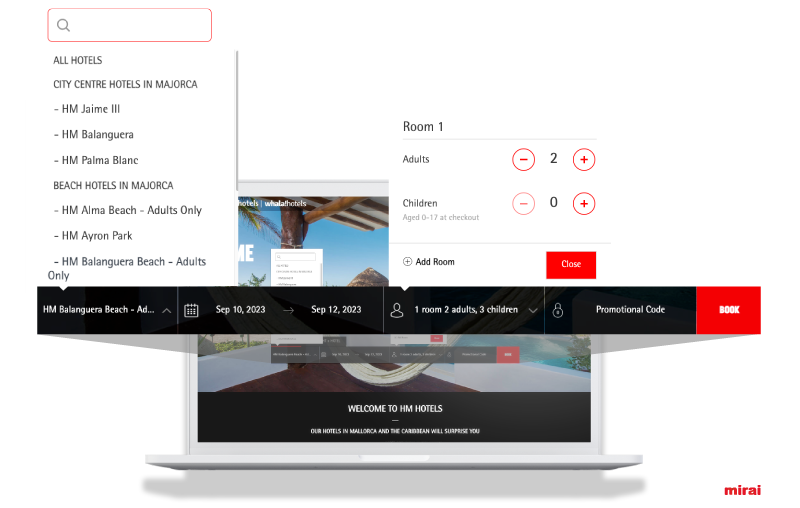
It’s already a challenge for customers to book a multiple occupancy room and distinguish between adults, children and babies. But this challenge is even greater when the technology available to hotels is not adequate. Some examples that hotels with this requirement will recognize include:
- If the age limit for children is 15 years old, why does my booking engine allow users to select a child aged 16, creating a false expectation for the customer?
- If the maximum occupancy is two adults and two children, why does it let the user select up to five people, again creating an expectation that cannot be met?
- If the hotel is for adults only, why does it allow users to select children?
- If five rooms is considered a group booking with all the associated special conditions, why let the customer choose that number of rooms?
Poor customer expectation management has a negative impact on your booking engine conversion, as frustration is one of the main reasons for abandoning a transaction. Leading your customer down a blind alley is something to avoid, because regaining customer trust is much harder than losing it in the first place. And it’s in our hands to make sure that doesn’t happen.
A frustrated customer will eventually turn to an OTA, even though they don’t provide a good solution to this problem either. They simply allow the customer to book “anything” and then pass the buck to the hotel to deal with the occupancy that the customer has selected, which the hotel may not accept, or accepts but with some variation.
If occupancy management is complex on individual hotel websites, it is even more so on chain websites. Each hotel may have a different configuration, including a mix of different age classifications for babies and children, adult-only hotels combined with family hotels, and city hotels that do not differentiate between adults and children. While the challenge is huge, technology companies should be the first line of support for hotels. And that’s what we’ve been working on at Mirai over the last few months.
The challenge and the solution
Until now, our booking system has dealt with almost all of the above cases in a satisfactory manner and prevented the customer from:
- Selecting children of an age that the hotel considers to be adults.
- Selecting children in adult-only hotels.
- Selecting more rooms than the hotel can accommodate.
- Selecting more adults or children than can be accommodated.
But the big news is that we’ve extended the same functionality to chain websites, where all these restrictions are made dynamic according to the hotel selected by the customer, so that:
- Hotels that charge per person, differentiating between adults and children, can coexist with those that restrict to adults only.
- There will no longer be problems with hotels that use different ages to classify children. The specific settings of each hotel will take precedence over the general settings for the chain.
- We have also solved another major challenge, which is the destination search, where hotels with different configurations are grouped together. We will show the customer the combination that “meets all the requirements”, never letting the customer choose an impossible combination. Once the customer has selected their occupancy, we will convert children to adults, if necessary, to display prices.
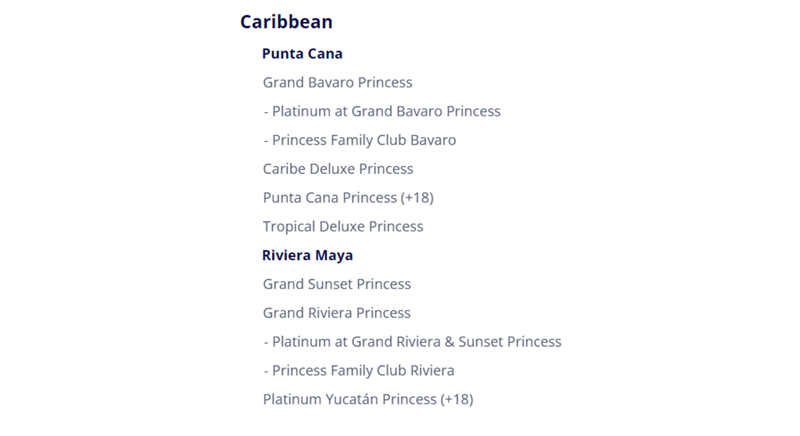
- While maintaining compatibility with bookings for more than one room.
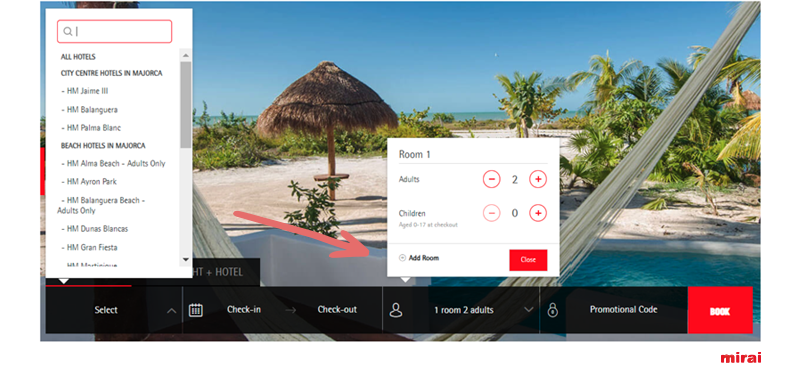
Why our system is better than Booking.com and Expedia
OTAs always ask for occupancy in the same way, regardless of the customer’s requirements. They typically consider children to be up to 17 and adults from 18. Based on that, they reclassify and price children for each hotel. This has two consequences:
- They can always offer alternative hotels.
- It can create booking discrepancies for the hotel. For example, the customer has requested a child place but has ended up in a hotel where they are considered to be an adult.
In practice, this means that the OTA always benefits because it never loses a booking request, at the expense of the hotel’s needs.

We cover all possible outcomes of the selected occupancy
A good system for selecting room occupancy is only the first step, and many engines, including OTAs, as we have seen, fall short. But the problem does not end there. There are many other variations that we have resolved, ensuring that your customers will always understand what they are seeing on your website.
Equivalent occupancy: If the occupancy requested in one hotel is suitable for another hotel, we will carry it across without inconveniencing the user. This applies to the majority of cases.
- Example 1: An adult remains as an adult when changing to another hotel, as long as they still meet the age requirement.
- Example 2: If a child in the first hotel is considered an adult in another hotel because of their age, we will automatically convert them to an adult.
If the previous occupancy does not work in another hotel, we alert the customer. It is possible that when the user selects a different hotel, the previously selected occupancy cannot be accommodated. In this case, the user is prompted to review the occupancy.
- Example 1: The user makes a booking enquiry with children at one hotel and then changes to an adults-only hotel.
- Example 2: The user selects a hotel where adults are considered adults from a different age. Without knowing the age of the adults (this information is never requested), they could be considered children in the new hotel.
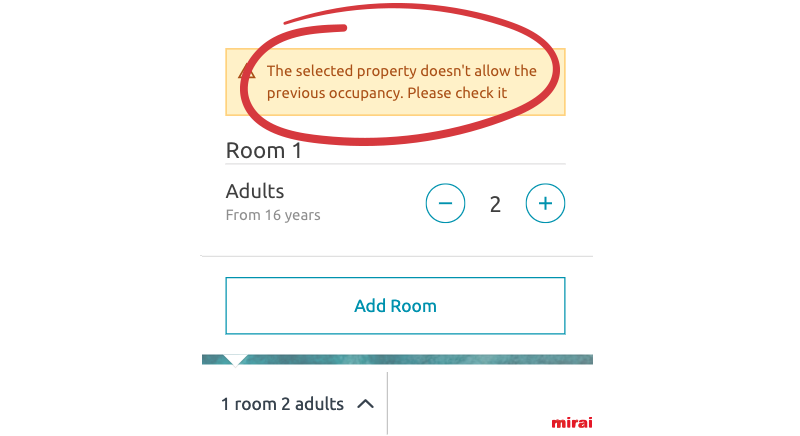
Searches by destination: When a user selects a destination instead of a hotel, they will be offered the occupancy options according to the available hotels.
- Example 1: In a destination where all hotels are adults-only, the user is prevented from selecting children.
- Example 2: In a destination where the hotels are different (adults-only, different boundaries between children and adults, etc.), a classification that works for all is offered.
Select occupancy before hotel: If the occupancy is suitable for the selected hotel, the system will proceed without disturbing the user. If not, the user will be informed.
In addition, as a new feature, on the first screen of the booking engine for chains with more than ten search criteria, we’ve added a search box to make it easier to find hotels, destinations and other tags:
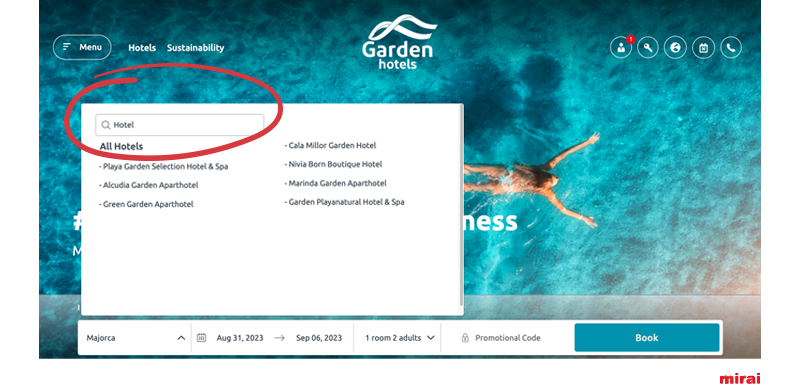
Conclusion
Frustrating customers by not helping them find or understand what they need is like rolling out the red carpet for OTAs. Satisfied customers who know exactly what they need to book are a guarantee of conversion. That’s what we strive for every day at Mirai, and this is just another example of our work.



